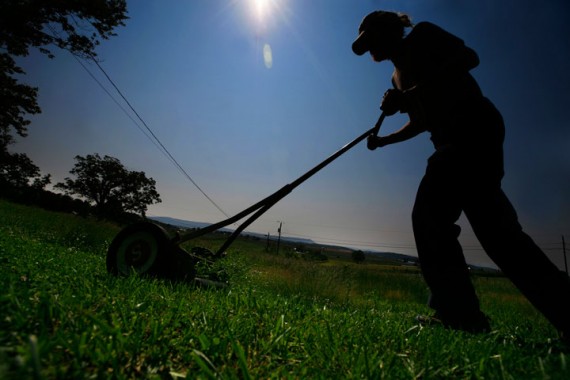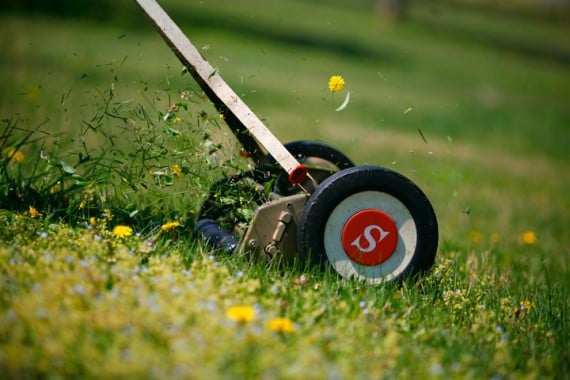The Quest for a Petroleum Free Lawn
It’s early morning and the neighbors are still asleep when I roll the mower out of the garage. I quickly position the machine to make the first pass and I’m off, grass flying and weeds tumbling. Half-an-hour later I’m starting to see progress. Half of my front yard looks as tidy as a new Marine’s head. The neighbors are still asleep. The birds are still chirping. The symphony of a rural morning is barely interrupted by the soft, sewing machine-like hum of my reel mower.
For the sake of full disclosure I will state this up front. I think mowing grass is a complete waste of time. It’s not that I mind the work, that I don’t like to be out in the sun, get dirty or break a sweat. It’s just that the mindless riding in circles, week after week, summer after summer that produces nothing besides giving my lawn the awkward nakedness of a freshly shorn sheep makes no sense to me.
Over my years of mowing grass I’ve also become conscious of another big, dirty fact. Lawn care requires oil. Lots of oil. It’s a vicious little cycle. The petroleum-based herbicides and fertilizers make your lawn grow so well you have to mow more which means pouring more oil into that gasoline-powered lawn machine of yours. The EPA estimates the mowing part alone uses 800 million gallons of gas in the U.S. each year. In fact according to their estimates 17 million more gallons of gas are spilled while we’re refueling our mowers (the oil it takes to make that much gas is as much as the Exxon Valdez spilled). The petroleum consumed in lawn care isn’t limited to the $4 a gallon gas we put into our mowers. Remember all the watering and applying pesticides and fertilizers and taking grass clippings to the landfill? Those products and processes are using as much oil as the act of mowing itself. Sounds like the value our culture places on a beautiful lawn was dreamed up in the marketing department of a petroleum company.
The environmental impact doesn’t end with oil consumption. Most powered lawn tools have little or no emissions control equipment. The EPA quantifies the pollution they create at nearly 125 pounds of CO2 and other pollutants per mower each season. To put that number into perspective for every hour that your mower runs it’s like eleven cars are being driven at interstate speeds. Is it possible that your lawn care is outweighing the fact that you own a Prius?
You would think that a person who has my reservations about mowing would live in an apartment, but my rural home is surrounded by acres of woods, orchards, gardens and grass. Literally acres. I fought back, planted flower beds, expanded the garden, let as much of my property go “natural” as possible, but in the end there was a certain amount of grass that had to be maintained to keep the skunks and ticks at bay. Factor in the orchard, the outbuildings and the walking paths and I was still stuck with about an acre and a half left to mow.
According to the experts I’m the wrong person to use a reel mower. My yard is too big and too bumpy. I have too many trees to mow around that drop branches that jam the reel. According to them I’m probably morally justified in continuing to use my gasoline mower. I could keep riding and still sleep at night. But something about all the oil that was going into my lawn nagged at my conscious. So last spring after doing the research and considering the options I downgraded from a riding mower to a walk behind reel mower and spent the summer with a human powered yard.
Green living Web sites and retailers trying to sell you a reel mower can spend hours extoling the virtues of the human-powered machines. They cut grass cleaner, leaving the grass healthier, more resistant to disease, pests and drought and spray your yard with a fine coat of mulch as they go. I have to admit in that first summer I didn’t notice any difference in how my lawn looked. Then again, I couldn’t care less if the neighbors admire the PGA qualities of my crab grass.
But I also discovered that using a reel mower gave me benefits beyond aesthetics or the money I was saving from not buying gasoline. I never used a stopwatch, but in the end, mowing with a reel mower seemed just as fast as my riding mower. This factors in not only the “seat time” involved in mowing but also the time spent on “support activities.” No dead batteries as you’re scrambling to beat the rain. No broken belts at 4:50 p.m. on a Saturday afternoon. No special trips to town for mower gas. And I was getting exercise. Health experts estimate using a reel mower burns about 375 calories an hour. Every spring my exercise time gets crammed to the edge of my schedule by mowing. By using the reel mower I was getting both done at the same time.

Then there were the small things. I didn’t have a front row seat to breathing in lawn mower exhaust. My clothes didn’t smell like gas fumes. I wasn’t exposed to gas or oil spills. I didn’t have to wear ear plugs for hours. The quietness of the mower allowed nature to continue on its business uninterrupted and allowed me to better observe it. Mowing had ceased to be an industrial activity in spite of nature and became an activity within nature, like hiking or biking.
Then one day, sometime in the fourth straight hour of pushing a mower around my lawn, it struck me. America’s energy crisis is not simply about the price of gas, or whether coal can be mined and burned cleanly, it is a crisis of our personal energy and how we spend it. Our lives are cluttered with time saving gadgets. We mount our lawnmowers and then, expending nearly no personal energy, blast through our yards. Why? So that we have the time to go to a gym and sit under fluorescent lights watching T.V. while riding a bike that doesn’t go anywhere?
It’s hard for me to understand how anyone with an average-sized backyard would use anything besides a reel mower. How did these little, practical machines get replaced by the hassle of the internal combustion engine? Maybe mowing is just another aspect of our suburban automobile culture. Gasoline gives you the upper hand on nature. It allows you to do things your way, on your schedule in the shortest amount of time. We clutter our life with technology that is supposed to save us time and effort, but how do we use the time and effort we save and at what expense to others and our environment is our leisure purchased?
I finished the lawn, quickly tucked my mower back in the garage and stepped back for a moment to admire my work. I expected to feel a rush of self-righteous satisfaction knowing that another week had passed without a drop of oil going into my lawn. But instead all I could see were the rest of the places in my life where my energy was being wasted, the places where my convenience was coming at the expense of others. Sometimes by taking a step in the right direction you can see more clearly how far you are from where you want to be. For me the real challenge lies ahead. Maybe the best place I could have started was in my own back yard.
Sidebar – Reel Mower Tips and Tricks
1. Keep your reel mower sharp and adjusted. A sharp properly adjusted mower requires less effort and cuts the grass cleaner. Most new mowers come with instructions and tools on how to do this. If not, find a shop that can do it for you.
2. Don’t let the grass get too high. Reel mowers do not cut effectively once the grass gets higher than the reel.
3. Pick up branches and other yard debris. Twigs, nuts, fruit and seeds will jam the reel.
4. If you have a large yard, divide it into parts and mow it over the course of several days.
5. Buy used – A brand new reel mower will cost you somewhere in the neighborhood of $100 to $300, comparable to slightly cheaper than their gasoline powered equivalents. Used reel mowers can often be found at garage sales or on Craigslist for less than $50.








